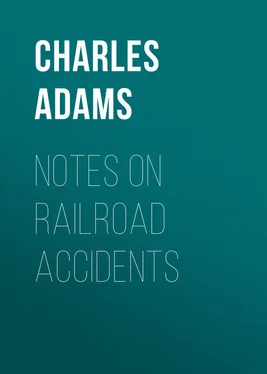Charles Adams - Notes on Railroad Accidents
Здесь есть возможность читать онлайн «Charles Adams - Notes on Railroad Accidents» — ознакомительный отрывок электронной книги совершенно бесплатно, а после прочтения отрывка купить полную версию. В некоторых случаях можно слушать аудио, скачать через торрент в формате fb2 и присутствует краткое содержание. Жанр: foreign_antique, foreign_prose, на английском языке. Описание произведения, (предисловие) а так же отзывы посетителей доступны на портале библиотеки ЛибКат.
- Название:Notes on Railroad Accidents
- Автор:
- Жанр:
- Год:неизвестен
- ISBN:нет данных
- Рейтинг книги:4 / 5. Голосов: 1
-
Избранное:Добавить в избранное
- Отзывы:
-
Ваша оценка:
- 80
- 1
- 2
- 3
- 4
- 5
Notes on Railroad Accidents: краткое содержание, описание и аннотация
Предлагаем к чтению аннотацию, описание, краткое содержание или предисловие (зависит от того, что написал сам автор книги «Notes on Railroad Accidents»). Если вы не нашли необходимую информацию о книге — напишите в комментариях, мы постараемся отыскать её.
Notes on Railroad Accidents — читать онлайн ознакомительный отрывок
Ниже представлен текст книги, разбитый по страницам. Система сохранения места последней прочитанной страницы, позволяет с удобством читать онлайн бесплатно книгу «Notes on Railroad Accidents», без необходимости каждый раз заново искать на чём Вы остановились. Поставьте закладку, и сможете в любой момент перейти на страницу, на которой закончили чтение.
Интервал:
Закладка:
CHAPTER VII.
TELEGRAPHIC COLLISIONS
And yet, even with the wires in active use, collisions will occasionally take place. They have sometimes, indeed, even been caused by the telegraph, so that railroad officials at two adjacent stations on the same road, having launched trains at each other beyond recall, have busied themselves while waiting for tidings of the inevitable collision in summoning medical assistance for those sure soon to be injured. In such cases, however, the mishap can almost invariably be traced to some defect in the system under which the telegraph is used; – such as a neglect to exact return messages to insure accuracy, or the delegating to inexperienced subordinates the work which can be properly performed only by a principal. This was singularly illustrated in a terrible collision which took place at Thorpe, between Norwich and Great Yarmouth, on the Great Eastern Railway in England, on the 10th of September, 1874. The line had in this place but a single track, and the mail train to Norwich, under the rule, had to wait at a station called Brundell until the arrival there of the evening express from Yarmouth, or until it received permission by the telegraph to proceed. On the evening of the disaster the express train was somewhat behind its time, and the inspector wrote a dispatch directing the mail to come forward without waiting for it. This dispatch he left in the telegraph office unsigned, while he went to attend to other matters. Just then the express train came along, and he at once allowed it to proceed. Hardly was it under way when the unsigned dispatch occurred to him, and the unfortunate man dashed to the telegraph office only to learn that the operator had forwarded it. Under the rules of the company no return message was required. A second dispatch was instantly sent to Brundell to stop the mail; the reply came back that the mail was gone. A collision was inevitable.
Конец ознакомительного фрагмента.
Текст предоставлен ООО «ЛитРес».
Прочитайте эту книгу целиком, купив полную легальную версию на ЛитРес.
Безопасно оплатить книгу можно банковской картой Visa, MasterCard, Maestro, со счета мобильного телефона, с платежного терминала, в салоне МТС или Связной, через PayPal, WebMoney, Яндекс.Деньги, QIWI Кошелек, бонусными картами или другим удобным Вам способом.
1
The bell-cord in America, notwithstanding the theoretical objections which have been urged to its adoption in other countries, has proved such a simple and perfect protection against dangers from inability to communicate between portions of trains that accidents from this cause do not enter into the consideration of American railroad managers. Yet they do, now and again, occur. For instance, on February 28, 1874, a passenger coach in a west-bound accommodation train of the Great Western railroad of Canada took fire from the falling of a lamp in the closet at its forward end. The bell-cord was for some reason not connected with the locomotive, and the train ran two miles before it could be stopped. The coach in question was entirely destroyed and eight passengers were either burned or suffocated, while no less than thirteen others sustained injuries in jumping from the train.
2
" Deodand. By this is meant whatever personal chattel is the immediate occasion of the death of any reasonable creature: which is forfeited to the king, to be applied to pious uses, and distributed in alms by his high almoner; though formerly destined to a more superstitious purpose. * * * Wherever the thing is in motion, not only that part which immediately gives the wounds (as the wheel which runs over his body,) but all things which move with it and help to make the wound more dangerous, (as the cart and loading, which increase the pressure of the wheel) are forfeited." — Blackstone, Book I, Chap. 8, XVI.
3
Ante pp. 18-19.
4
Railroads: their Origin and Problems, p. 49.
5
A collision very similar to that at Camphill occurred upon the Erie railway at a point about 20 miles west of Port Jervis on the afternoon of July 15, 1864. The train in this case consisted of eighteen cars, in which were some 85 °Confederate soldiers on their way under guard to the prisoner's camp at Elmira. A coal train consisting of 50 loaded cars from the hanch took the main line at Lackawaxen. The telegraph operator there informed its conductor that the track was clear, and, while rounding a sharp reversed curve, the two trains came together, the one going at about twelve and the other at some twenty miles an hour. Some 60 of the soldiers, besides a number of train hands were killed on the spot, and 120 more were seriously injured, some of them fatally.
This disaster occurred in the midst of some of the most important operations of the Rebellion and excited at the time hardly any notice. There was a suggestive military promptness in the subsequent proceedings. "T. J. Ridgeway, Esq., Associate Judge of Pike County, was soon on the spot, and, after consultation with Mr. Riddle [the superintendent of the Erie road] and the officer in command of the men, a jury was impanneled and an inquest held; after which a large trench was dug by the soldiers and the railway employés, 76 feet long, 8 feet wide and 6 feet deep, in which the bodies were at once interred in boxes, hastily constructed – one being allotted to four rebels, and one to each Union soldier." There were sixteen of the latter killed.
6
Chapter XIV, XVI.
Интервал:
Закладка:
Похожие книги на «Notes on Railroad Accidents»
Представляем Вашему вниманию похожие книги на «Notes on Railroad Accidents» списком для выбора. Мы отобрали схожую по названию и смыслу литературу в надежде предоставить читателям больше вариантов отыскать новые, интересные, ещё непрочитанные произведения.
Обсуждение, отзывы о книге «Notes on Railroad Accidents» и просто собственные мнения читателей. Оставьте ваши комментарии, напишите, что Вы думаете о произведении, его смысле или главных героях. Укажите что конкретно понравилось, а что нет, и почему Вы так считаете.












